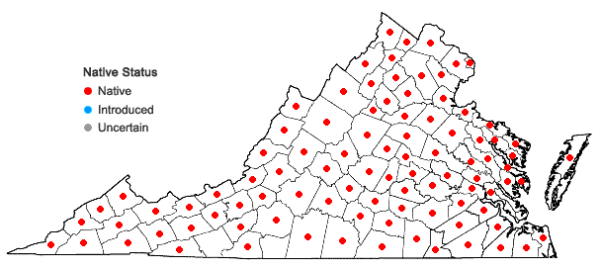Wildflower of the Year 2023 Hollow Joe-Pye-Weed (Eutrochium fistulosum)
VNPS offers Joe-Pye-Weed artwork on T-Shirts, Tote Bags, and Coffee Mugs. Visit our Online Store to order.
Hollow Joe-pye-weed is a perennial herb that may grow as tall as 35 dm (about 11.5 feet). Stems are frequently purple and, when young, are covered with a thin, glaucous, layer of wax. Cross sections of stems will reveal the presence of hollow cavities in the central pith region. Leaves are whorled, 3-7 per node; leaf shape varies from narrowly to broadly elliptic or lanceolate or narrowly oblong, 2-6 cm wide and 12-25 cm long; leaves are tapered at both base and apex; leaf surfaces are wrinkled, finely hairy or hairless, and may be resin-dotted or not; leaf veins are pinnate. Flowers are small and clustered into cylindric heads consisting of 4-7 individual pink to purple flowers; basal bracts of the heads (phyllaries) are 6.5-9 mm long; numerous groups of flower-bearing heads arise from several uppermost stem nodes and form multiple corymbs that range from nearly globose to almost flat-topped. Individual flowers are of the “discoid” form found in the Daisy Family. Paired stigmas of individual flowers can often be seen extending above the heads, but other flower details are small and hidden by the phyllaries. Fruits are single-seeded achenes that disperse by wind, assisted by remnants of sepals at their apex—overall the pattern is reminiscent of the parachute-like fruits of the Common Dandelion.
Name and Relationships
The genus name, Eutrochium, is derived from Greek words meaning “true wheel,” apparently in reference to the whorled leaves. The species portion of the binomial, “fistulosum,” refers to the hollow pith cavity. All five species of Eutrochium include reference to Joe Pye in their common names; Joe Pye is the Christian name of a Mohican chief and healer who lived in Stockbridge, Massachusetts, from 1740 to 1785. Eutrochium is closely related to the genus Eupatorium (Thoroughworts); species of Eutrochium have whorled leaves and pink/purple flowers whereas leaves are opposite and flowers are white in Eupatorium. Eutrochium fistulosum was first named as a species of Eupatorium in 1841 by Joseph Barratt, a botanist based in Middletown, Connecticut. Eutrochium and Eupatorium join some 1,900 other genera that constitute the plant family Asteraceae (Daisy Family).
In the Garden
Hollow Joe-pye-weed makes an excellent garden plant. It does well in full sun and soils that remain somewhat moist through the summer. Because the stems are so tall, it is best placed near the rear of garden borders where its large flower clusters provide color and attract diverse pollinators from mid-summer into fall. After flowering, the dry fruits/seed clusters provide soft textural elements. Pruning stems to about 2 feet in mid-May to early June will result in shorter plants that still flower vigorously. Eutrochium species are easily propagated by seed, stem cuttings, or by division. Seeds can be planted in fall or held until spring. Stem cuttings about 4-6 inches long will root readily if taken in spring or early summer; established clumps can be divided in fall after the shoots have withered. Joe-pye-weeds are relatively deer- and rabbit-resistant.
In the Wild
Hollow Joe-pye-weed grows naturally in a wide variety of habitats with moist soil; it shows some preference for soils that are moderately to strongly base-rich. All species of the genus, when flowering, attract numerous and diverse pollinators: butterflies, skippers, honeybees, various native bees, hummingbirds, and wasps sip nectar from the small but abundant flowers. Caterpillars of the Three-lined flower moth (Schinia trifascia), the Eupatorium Borer Moth (Papaipema eupatorii) and Clymene Moth (Haploa clymene) feed on vegetative portions of the plant; Swamp Sparrows (Melospiza georgiana) eat the seeds.
Human Uses
One commonly cited medicinal use of Eutrochium fistulosum, and related species of Eutrochium and Eupatorium, has been to make a diuretic tea from the leaves to treat a variety of urinary, kidney, and liver complaints. VNPS makes no endorsement of medicinal use of this or other native plants.

Photo by Joe Shlabotnik at Flickr license CC BY-NC-SA 2.0.
Conservation Status
Eutrochium fistulosum is common and abundant throughout its range.
Where to See It
The native range of Eutrochium fistulosum extends from southern New England south to Florida and west to Missouri, Oklahoma and east Texas. The species has been documented to occur in almost every county of Virginia.
 Joe-Pye-Weed Distribution – Digital Atlas of Virginia Flora
Joe-Pye-Weed Distribution – Digital Atlas of Virginia Flora
View or download the Hollow Joe-Pye-Weed Brochure (PDF)
Gardeners should not collect Hollow Joe-Pye-Weed in the wild and should be certain that all native plants purchased for home gardens have been nursery-propagated, not wild-collected. For retail sources of nursery-propagated plants and responsibly collected seeds, visit https://vnps.org, email info@vnps.org, or call 540-837-1600. To see and learn more about interesting species of plants native to Virginia, visit https://vnps.org and contact your local chapter of VNPS (https://vnps.org/chapters) for times and dates of programs and wildflower walks in your area.
Text and photos by W. John Hayden, VNPS Botany Chair




